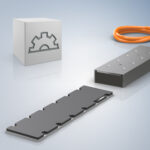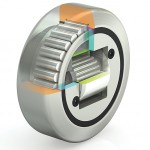Actom Signalling, a Southern African railway signal-equipment company, has found minimal wear in accelerated wear testing on Vesconite slides in its point machines. These machines control railway tracks and switch the tracks to which particular trains will be directed.
Actom engineering projects and contracts development technician Wayne Meyer confirms the test results. Testing was executed over a few days in late 2022 on a randomly selected B1 Switchmatic Point Machine that was taken out of operation for the express purpose of testing the point machine’s performance.
“We must back our products so periodically we do these tests,” says Meyer. “They provide comfort to our customers on the performance of our machines.”
The tests put the machine through its expected operating life. More than 5,000 actuations (movements of the point machine drive bar) were tested at the company’s factory in Germiston, South Africa. Included in the testing were Vesconite slides located around the detection, lock, and drive bars where they exit the machine housing.

The point system blades and bars also run on Vesconite track, so are enclosed within Vesconite when they are within the point system housing. Meyer notes that most of the wear — around 0.17 mm — was on the bottom Vesconite slides. “This is very little for the amount of work that was done,” he says.
Wear on the topmost and side liners was almost undetectable, with wear of 0.05 mm being present. Point machines are critical in controlling the directional change of a train and for the safety of rail services.
Among the important components of the point machine are the detection blades, which determine the position of the right and left lines on the track; the locking blades, which physically locks the rail in place in a new position; and the drive slide, which is used to push the tracks into the correct position.
“Each actuation of the B1 Switchmatic point machine involves a 300-mm stroke, so there’s 300 mm of movement over the Vesconite liner each time the machine actuates,” says Meyer. “For the amount of wear, that’s very good.”
The B1 Switchmatic is Actom’s most popular point system and is a well-tested machine that was first developed in the 1980s. It’s the model on which Actom’s other point systems are based. Actom has also developed the C1-H clamp lock point machine, the in-sleeper or integrated point machine, and the yard point machine — all of which include Actom’s important safety features and locking mechanism.
The C1-H is a smaller machine that was developed in the 2000s and is frequently used on passenger rails on which the rail tracks are normally located closer to one another than would be the case with freight rail. A yard point machine is a robust, portable machine which is used in shunting yards and operated with high frequency. The in-sleeper machine is Actom’s newest machine to combat vandalism and theft by being small enough to be installed securely between the rails and inside the concrete sleepers.
All these machines make extensive use of Vesconite; some 40 and 50-year-old machines still operating feature low-friction wear-resistant Vesconite that hasn’t failed yet. For more information, visit vesconite.com.







Leave a Reply
You must be logged in to post a comment.